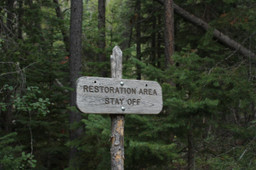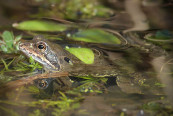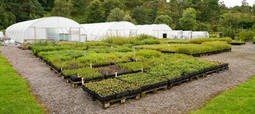
Rewilding and restoration success stories revealed through sound
When we look only at cold hard facts and figures, and base judgements and decisions only on visuals or numbers, we miss much that we need to know about the world. Listening to the sounds of an ecosystem can reveal far more than simply looking alone.
The importance of monitoring and recording progress in rewilding and restoration has long been clear. In recent years, however, there have been many discussions about what exactly constitutes success, and how success or failure is best monitored and recorded in this arena.
There is an increasing understanding that soundscapes can reveal details of an environmental destruction or an environmental recovery in profound ways – providing us with details about an ecosystem and its interactions that we cannot really understand through other means.
Sound recordings also give us the chance to profoundly experience restored or rewilded environments in deeper and more meaningful ways. In a world where progress often seems far too slow and small, listening to functioning, thriving ecosystems that have been brought back can give us hope, and help us to feel more connected to these crucial efforts.
The importance of sound in rewilding and restoration efforts
Sound recording has long been important in conservation – helping to educate the public as well as those operating scientifically in the field. Through listening to the sounds of an environment, we can truly begin to appreciate the profound impact that we, humans, are having on the world around us.
Sound recordists have shown us the impact of Anthropocene noise in a range of different terrestrial and marine environments. They have also shown us how biophony (the sound of living creatures within an ecosystem) alters based not only on geophony (other natural sounds) but also due to our own human-made additions to the soundscape.

Recording soundscapes has allowed us to see, all too clearly, just how much we have lost, and how our soundscapes have altered so dramatically during the Anthropocene.
The background to our lives today is, all too often, less rich and complex than that our distant ancestors would have known. Often less reported, but no less important, is how sound recordings of a soundscape can help us see what we’re doing right.
It’s easy to become disheartened when we contemplate the immense destruction humanity has wrought, and is wreaking, on this planet. But around the world, in a range of different environments, humanity shows that it is capable to right the wrongs of the past through rewilding and restoration efforts. And through recording sound in restored and rewilded landscapes, we can begin to see success.
From identifying the recovery of specific species, to witnessing an overall increase in biodiversity within an ecosystem, soundscapes can allow us to monitor progress in rewilding and restoration. They can give us things to celebrate as well as providing information to further guide such projects moving forwards.
These recordings, therefore, are a hugely important tool not only in highlighting serious problems, but also in showing us the pathway to put things right. We can learn more to make sure that such projects continue in the right direction, and gain hope for a better future for all.
Monitoring progress in rewilding and restoration through sound
There is an increasing understanding in rewilding and ecosystem restoration that we need to change our mindset when it comes to nature ecological repair. We must move beyond consideration of individual species or individual habitats and take a broader view.
We need to look at patterns, larger systems – recognising the dynamics of those patterns and systems and the interactions between all the elements within them in more holistic ways. To restore an ecosystem, we need to restore its function. And to do so, we need a much deeper understanding of the whole, as well as its individual elements.
One of the challenges in monitoring progress, therefore, is that individual measurements such as individual species numbers cannot provide an accurate representation because they cannot even get close to representing a true picture of ecosystem function as a whole.
A lot of work has been done in recent years to review the best methods for monitoring progress in rewilding and restoration. Indicators of change have often been identified to monitor the impact of restoration work or species introduction. These might include indicators such as invertebrates, or fungi, for example, whose presence and numbers can be clear indicators that things are moving in a positive direction.
Of course, monitoring multiple indicators of change can begin to allow us to build up a clearer picture of the impact of our actions. It can give us robust data that can be analysed using such tools as the Biodiversity Quality Calculator to provide information on species richness, turnover, rarity and biomass.
But even this information is not enough to give us all the information we need about ecosystem function. And this is where soundscape recording can come in. Soundscape recording can provide us with even more data about what is happening within an ecosystem, and also give us a broader, larger scale view than some more intensive forms of monitoring.
Examples show that when soundscape recordings are not used – something can be missed. For example, studies have shown that species richness in continuous forest and in fragmented forest differed little. But when soundscapes are compared, we can discover that sound diversity is greater in larger areas of forest than in fragmented ones.
Using this extra layer of crucial data – listening as well as looking when monitoring rewilding or ecosystem restoration sites – we can gain more information about what we’re doing right, and what still needs to be done. Furthermore, sound recording can be cost-effective compared to other monitoring techniques.
Success stories revealed through soundscape recording
Within the field of soundscape recording, there are many wonderful examples of people doing great work. But below, we’ll focus on success stories that have been revealed through five specific examples of soundscape recording.
Healthy soundscapes in restored reefs
In ecosystem restoration, we don’t always know whether our efforts will truly be successful. We often have to make an attempt to do something about degradation without really knowing whether we actually can.

For years, the Mars Coral Reef Project has been attempting to restore reefs in central Indonesia by placing hexagon metal frames called ‘reef stars’ over an area of thousands of square meters of coral reef that had been destroyed by pollution and bleaching.
The hope was that this restoration project would be able to rebuild the massive ecosystem that the original reefs once supported. However, it was truly unclear whether or not this would be possible.
Now, a new joint project between the University of Bristol and the University of Exeter has found evidence from acoustic recordings taken between 2018 and 2019 that seem to give a positive outlook on the restored reef’s future.
When the sound recordings were analyzed, they revealed that though the sound recordings from the restored reef were not identical to those of healthy reefs, they had a similar sound diversity. This implies a recovering ecosystem. The diversity of sounds recorded was much higher than recordings of degraded reefs.
The lead author of the paper, Dr Tim Lamont from the University of Exeter and Mars Coral Reef Restoration Project said:
“ Restoration projects can be successful at growing coral, but that’s only part of the ecosystem. This study provides exciting evidence that restoration really works for the other reef creatures too – by listening to the reefs, we’ve documented the return of a diverse range of animals.”
However, while we can all be buoyed by this success story thus far, Dr Lamond added this caveat:
“Our study shows that reef restoration can really work, but it’s only part of a solution that must also include rapid action on climate change and other threats to reefs worldwide.”
So, while the sound diversity on these restored reefs gives hope that the reefs have a good chance of becoming self sustaining, we should not become complacent about eliminating risks to these reefs in the first place.
The amazing sounds of landscapes restored by ecosystem engineers
One very important woodland ecosystem engineer was lost from British woodlands during the Mediaeval period: the beaver. Fortunately, they have now been reintroduced in some areas. Beavers are a keystone species, and one of the best known examples of an allogenic ecosystem engineer.
Allogenic ecosystem engineers shape their environments in mechanical ways. Beavers coppice trees and dam waterways, and so can play an important role in water catchment and flood prevention. Their engineering efforts also create habitat for a wide range of different creatures.

At this year’s Chelsea Flower Show, the Best Show Garden was the Rewilding Britain Garden by garden designers Urquhart and Hunt. This garden sought to highlight the key role that beavers play as ecosystem engineers in landscape restoration.
Showing how rewilding can benefit nature, climate and people, their garden introduced the wider gardening public to the sight and beauty of ecosystems restored by these amazing natural rewilders. But as well as providing the visuals, the installation included the sounds of the environment too.
A soundscape was installed to give visitors a taste of a future landscape alive with nature after the reintroduction of this crucial ecosystem engineer in southwest England.
The sound installation was recorded and produced by Sound Matters. In order to create it, they travelled to a number of different areas where beavers have been reintroduced, including those at Derek Gow’s consultancy and at other locations including along the Otter River.
The recorded soundscapes gave insight into the success of these reintroduction projects, and visitors to the Chelsea Flower Show were able to hear the rich biodiversity of the environments the beavers helped shape.
Sound reveals resurrection of neglected ponds
A remarkable project, inspired by Richard Waddingham, a Norfolk farmer, has been working on recovering and restoring Norfolk’s lost ponds.
Norfolk has more ponds than any other English county; around 23,000 ponds. In North Norfolk many of these ponds were created in the 17-19th centuries as marl pits to provide lime-rich clay to improve the soil for crops. Though often man-made, these ponds became important ecosystems for a range of aquatic and marginal flora and fauna.
However, over the last 50 years many of these ponds have suffered neglected or been filled in, largely as a result of changes in farming practices. Many ponds in Norfolk farmland have become overgrown with trees or have been in-filled to create more agricultural land, which has led to the loss of ecological diversity.
Today, the Norfolk Pond Project is working to recover and restore these ghost ponds, and is passionate about sharing the myriad benefits of doing so. From water chemistry, aquatic plants and invertebrates to buffer-zone terrestrial wildflowers and pollinators and the farmland birds that benefit higher up the food chain, a suite of research demonstrates the tangible benefits of farmland pond restoration, even in intensively farmed landscapes.

Where there is life in a pond there is sound; for example, water boatmen, respiring plants and water beetles all produce sounds, so by listening to the underwater sounds in a pond, we can learn a lot about its ecological function and health.
Sound recordist and electronic sound artist Tom Fisher recorded the resurrection of Norfolks’s neglected ponds, witnessing through this the creation of each vibrant and biodiverse oasis as these were brought back to life. Plants and wildlife began to return to land severely depleted and degraded by agriculture. His composition ‘A Ghost Pond Emerges’ celebrates the transformation of one such restored pool, now brimming with life.
Estate rewilding success captured in birdsong
One of the best known rewilding projects in England is that ongoing at Knepp Estate, in West Sussex. This estate is now known for its pioneering rewilding efforts and increasing biodiversity, and is considered a leading light for conservation and restoration in the UK.
This site demonstrates clearly, in a number of ways, that when we give nature space and free reign, recovery is not only possible, but can actually occur in a dramatically short period of time. The project’s practices and actions have enabled a reversal of the catastrophic decline in species and diversity in Britain over the past 50 years.
Knepp is a 3,500 acre estate just south of Horsham, West Sussex. Since 2001, the land – once intensively farmed – has been devoted to a pioneering rewilding project. Using grazing animals as the drivers of habitat creation, and with the restoration of dynamic, natural water courses, the project has seen extraordinary increases in wildlife, underpinned by their driving principle to establish a functioning ecosystem where nature is given as much freedom as possible.
Extremely rare species like turtle doves, nightingales, peregrine falcons, and purple emperor butterflies are now breeding here; and populations of more common species are rocketing.
Sound recordings created on the Knepp estate by Hazel Reeves since 2021 have captured the successes of this rewilding story – recording the ever increasing biodiversity of the estate, especially birds.
As former agricultural fields become thorny scrub, a habitat that is now largely absent from the surrounding landscapes, a nesting habitat is provided for a remarkable number of different bird species including nightingales, turtle doves and whitethroats. And the rich and functioning ecosystems are recorded through sound.
Sound recording in Caledonian Forest regeneration site
In Scotland, rewilding and restoration of the Caledonian Forest advances apace. Driving this is the award-winning conservation charity, Trees for Life, working to once more make the ancient Caledonian Forest of the Highlands one of UK’s wildest landscapes.
Their latest and largest project, Affric Highlands, will play a major role in restoring Scotland’s natural environment. Over thirty years, it will link up a huge swathe of 500,000 acres of the Scottish Highlands as one vast nature recovery area.

Practical action to connect rewilded areas is due to begin in 2023. During the same year, the 10,000 acre estate at Dundreggan in Glenmoriston, where impressive restoration work of the Caledonian Forest has already been done, will become the site of the world’s first Rewilding Centre.
Dundreggan is the charity’s flagship regeneration site, and is gaining international recognition for its biodiversity. More than 3,000 species have been discovered on the site, including 10 found nowhere else in the UK.
Composer and audio specialist Huw McGregor has now carried out an investigation at the Inverness-shire estate as part of his Woodland Soundscape Project. His initial recordings at the site include the dawn and dusk choruses. Such recordings can be used to study bird population numbers and the range of species, as well as how species use different spaces to alter their songs or how sounds such as waterfalls, roads and human activity affect their behavior.
Recordings made within this landscape by Huw McGregor give insights into this biodiverse natural environment, shedding light on the success of this restoration project, as well as providing useful insights for the future.
These are just a few examples of rewilding and restoration success stories revealed through sound. But what these sound recordings reveal is that much is possible when it comes to restoration and rewilding.
The work we put in to repair our planet really can make a big difference. We may not be able to reclaim all we have already lost, but we can certainly turn the tables and start heading back in the right direction.
And listening is a great step on the road to recovery.
Earth.fm is a completely free streaming service of 1000+ nature sounds from around the world, offering natural soundscapes and guided meditations for people who wish to listen to nature, relax, and become more connected. Launched in 2022, Earth.fm is a non-profit and a 1% for the Planet Environmental Partner.
Check out our recordings of nature ambience from sound recordists and artists spanning the globe, our thematic playlists of immersive soundscapes and our Wind Is the Original Radio podcast.
You can join the Earth.fm family by signing up for our newsletter of weekly inspiration for your precious ears, or become a member to enjoy the extra Earth.fm features and goodies and support us on our mission.
Subscription fees contribute to growing our library of authentic nature sounds, research into topics like noise pollution and the connection between nature and mental wellbeing, as well as funding grants that support emerging nature sound recordists from underprivileged communities.
